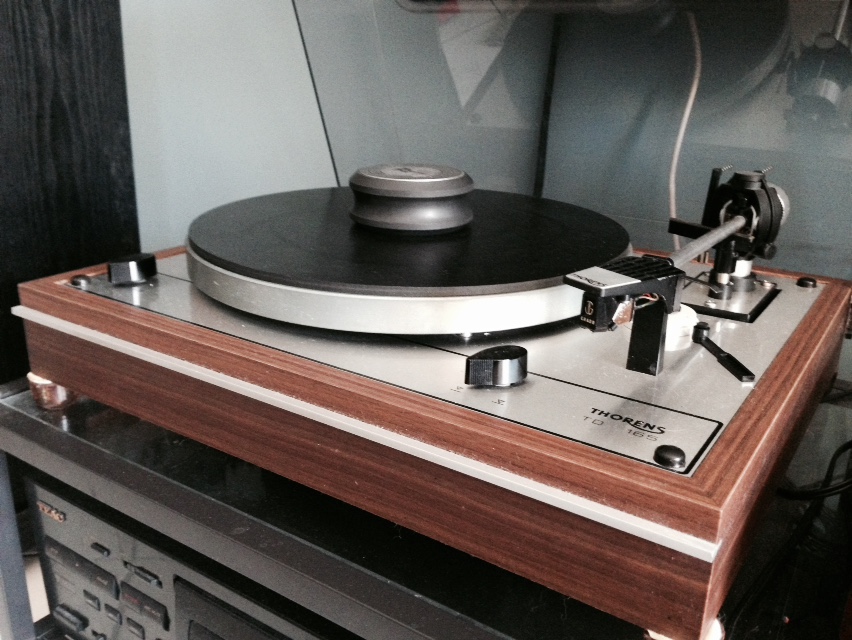 I’ve been always advising to get rid of the rubber mat on old Thorens turntables.
I’ve been always advising to get rid of the rubber mat on old Thorens turntables.
Lately, I’ve been reconsidering some of my well established views. The otherwise excellent Funk Firm Achromat I’ve been using for years looks a rather warped today. So I tried a felt mat I had spared and…. differences? Well…. really tough to tell.
It is debated whether the stock Thorens rubber mats of the 70s are still usable or not. Basically, the function of a turntable mat is to avoid placing our precious records directly on a rough metal plate. Modern turntables that use acrylic plates do not need a mat. The use of rubber in the past was due to its isolating properties and of course to their soft protection for the records.
The first time I replaced my Thorens TD 165’s rubber mat was when a technician ensured me I could have scrapped it for its own felt mat. So I equipped the vintage Thorens with a electric blue felt mat. It was very thin and I had no idea I should have adjusted the VTA…. How naive of me…
 After a couple of years using that felt mat plus a graphite clamp sold by the same turntable tweaker, I stumbled upon an enthusiastic review on my to-go online magazine – TNT-Audio. Geoff Husband, one of my favorite reviewers, wrote flattering words on the efficacy of a thick (5 mm!) mat by The Pink Farm, the Achromat. It’s made of nearly the same material as vinyl records – foamed “polyvinyl chloride (PVC) – it basically thickens the vinyl on the plate, allowing a better dispersion of the vibrations in a larger volume of the same material. His old Thorens TD-160 reportedly benefited a lot from the mat upgrade. I was sold. I bought an expensive Achromat for nearly 100 euros! And I was happy with the results as well (I also sold the graphite clamp).
After a couple of years using that felt mat plus a graphite clamp sold by the same turntable tweaker, I stumbled upon an enthusiastic review on my to-go online magazine – TNT-Audio. Geoff Husband, one of my favorite reviewers, wrote flattering words on the efficacy of a thick (5 mm!) mat by The Pink Farm, the Achromat. It’s made of nearly the same material as vinyl records – foamed “polyvinyl chloride (PVC) – it basically thickens the vinyl on the plate, allowing a better dispersion of the vibrations in a larger volume of the same material. His old Thorens TD-160 reportedly benefited a lot from the mat upgrade. I was sold. I bought an expensive Achromat for nearly 100 euros! And I was happy with the results as well (I also sold the graphite clamp).
Years passed and I discovered a firm near the place where I live that can laser cut any shape of PVC that you might desire. Thicknesses available were 3 and 5 mm. So I gave it a try and requested a 5 mm thick circle of the PVC that – besides being white – it looked all the same as the Achromat for less than half the cost. I could not even hear any performance differences between the two. I didn’t stick with the custom cut PVC mat just because the material itself is white, unless you specify otherwise. I just couldn’t bear the sight of my “new” TD-160 with a white mat…
So I went on with the Achromat for a while, until one day I noticed the wobble. I couldn’t believe my eyes. The expensive and excellent Achromat was warped like an old record. I could see the tonearm and headshell going up and down. Unbearable…
So I went for the original rubber mats. I have both older (see the picture) and newer types (with just two rings). Again, I couldn’t hear much difference. I still had a black felt mat, thicker than the blue one I used once. And yes, the felt mat “felt” good too. I didn’t know what to choose. I thought about having a black PVC mat done by the firm I mentioned above. But would it be worth the effort? I kept trying both types of stock rubber mats alternating to the felt mat and the white PVC mat. Not many differences. So the white PVC was out of the game just because of its looks. It struck me that a felt mat would just adjust to the shape of the platter beneath and the record above. But hearing no difference with the rubber mats, I decided that their electrostatic isolation properties would be a plus. I chose the older type, with more rings – more stability and more contact, especially at the center, where with the other type I could see the record was not well in contact (unless I used a clamp).
It must be said that when I first bought the Achromat, my turntable had been dampened with tar sheets. The one I am using now is not dampened, except for the bottom board. So maybe I can’t hear differences with or without the Achromat because an undampened chassis won’t let me hear any. Plus, I did all my tests with the Shure Me97 cartridge mounting just an elliptical – instead of hyperelliptical – replacement stylus. I’ll come back to this after I do more tests with my “new” Audiotechnica AT95HE or when I put one of my Grados back to work.
Meanwhile, following the old rule “if it’s working don’t mess with it”, I put the older type vintage rubber mat back to work. More rings are better than just two. I added a small weight to stabilize the records at the center and to secure more contact.
And the TD-160 now looks even more vintage…